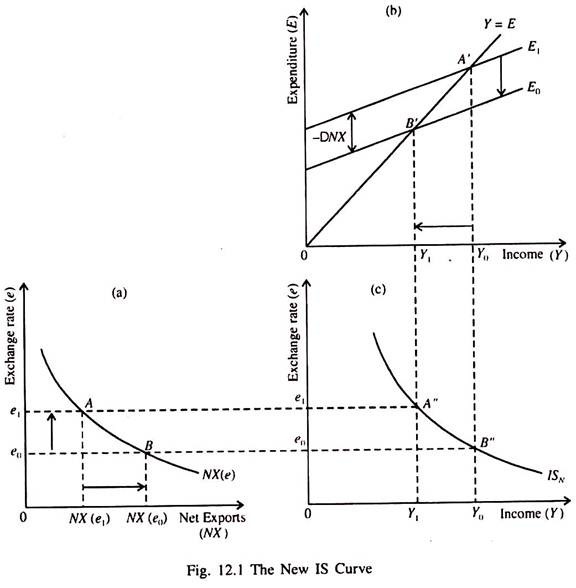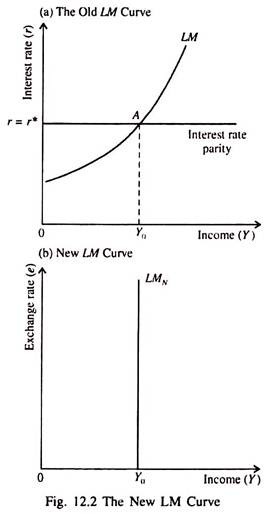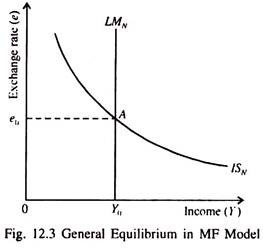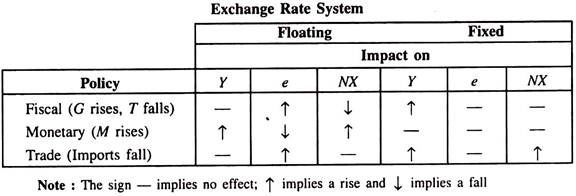Let us make an in-depth study of the Mundell-Flemming Model. After reading this article you will learn about: 1. Meaning of the Mundell-Fleming Model 2. Main Message of Mundell-Flemming Model.
Meaning of the Mundell-Fleming Model:
The basic Mundell-Fleming model — like the IS-LM model — is based on the assumption of fixed price level and shows the interaction between the goods market and the money market.
The model explains the causes of short-run fluctuations in aggregate income (or, what comes to the same thing, shifts in the ad curve) in an open economy.
The Mundell-Fleming model is based on a very restrictive assumption. It considers a small open economy with perfect capital mobility.
ADVERTISEMENTS:
This means that the economy can borrow or lend freely from the international capital markets at the prevailing rate of interest since its domestic rate of interest is determined by the world rate of interest. So, the rate of interest is not a policy variable in the small economy being studied.
This means that macroeconomic adjustment occurs only through exchange rate changes. In other words, the brunt of adjustment is borne by exchange rate movements in foreign exchange markets to maintain the officially determined exchange rate. The central bank permits the exchange rate to move up or down in response to changing economic conditions.
The basic assumption of this model is that the domestic rate of interest (r) is equal to the world rate of interest (r*) in a small open economy with perfect capital mobility. No doubt any change within the domestic economy may alter the domestic rate of interest, but the rate of interest cannot stay out of line with the world rate of interest for long.
The difference between the two, if any, is removed quickly through inflows and outflows of financial capital.
ADVERTISEMENTS:
It may be recalled that “smallness” of a country has no relation to its size. A small country is one which cannot alter the world rate of interest through its own borrowing and lending activities. In contrast, a large economy is one which has market (bargaining) power so that it can exert influence over the world rate of interest.
For such a country, either international capital mobility is far from perfect, or the country is so large that it can exert influence on world capital markets.
The main prediction from the Mundell-Fleming model is that the behaviour of an economy depends crucially on the exchange rate system it adopts, i.e., whether it operates a floating exchange rate system or a fixed exchange rate system. We start with adjustment under a floating exchange rate system, in which case there is no central bank intervention in the foreign exchange market.
In such a situation, if the domestic interest rate goes above the world rate, foreigners will start lending to the home country. This capital inflow will create excess supply of funds and the domestic rate of interest r again will fall to r*.
ADVERTISEMENTS:
The converse is also true. If, for some reason, the domestic rate of interest (r) falls below r*, there will be capital outflow from the home country and the resulting shortage of funds will push up r to the level of r*. Thus, in a world of perfect capital mobility, r will quickly get adjusted to r*.
The Open Economy IS Curve:
In the Mundell-Fleming model, the market for goods and services is expressed by the following equation:
Y = C(Y – T) + I(r*) + G + NX(e) … (1)
where all the terms have their usual meanings. Here investment depends on the world rate of interest r* since r = r* and NX depends on the exchange rate e which is the price of a foreign currency in terms of domestic currency.
In the Mundell-Fleming model, it is assumed that the price levels at home and abroad remain fixed. So, there is no difference between real exchange rate and nominal exchange rate. We now illustrate the equation of the goods market equilibrium in Fig. 12.1.
In part (a), an increase in the rate from e0 to e1, lowers net exports from NX(e0) to NX(e1). As a result, the planned expenditure line E1 shifts downward to E0. Consequently, income falls from Y1 to Y0. In part (c), we show the new IS curve, which is the locus of points, indicating alternative combinations of e and Y which ensure equilibrium in the goods market.
The new IS curve is derived by following this sequence:
ADVERTISEMENTS:
e rises → NX falls → Y falls
The Open Economy LM Curve:
The equilibrium condition of the money market in the Mundell-Fleming model is:
M = L(r*, Y) … (2)
ADVERTISEMENTS:
since r = r*.
Here the supply of money equals its demand and demand for money varies inversely with r* and the positively with Y. In this model, M remains exogenously fixed by the central bank.
The new LM curve, as shown in Fig. 12.2(b), is vertical — since the equation (2) has no relation to the exchange rate. This equation determines only Y, whether e is high or low. In Fig. 12.2(a), we draw the closed economy LM curve as also a horizontal line showing parity between r and r*.
The intersection of the two curves at the point A determines the equilibrium level of income Y0, which has no relation to e, shown on the vertical axis of Fig. 12.2(b). This is why the new (open economy) LM curve is vertical. The LMN curve of Fig. 12.2(b) is derived from r* and the closed economy LM curve, shown in Fig. 12.2(a).
ADVERTISEMENTS:
General Equilibrium:
In the Fig. 12.3, we show the general equilibrium of goods market and the money market. The equilibrium income (Y0) and exchange rate (e0) are determined simultaneously at point A where the IS and LM curves intersect.
Main Message of Mundell-Flemming Model:
ADVERTISEMENTS:
The main message of the Mundell-Fleming model is that the effect of any economic policy (fiscal, monetary or trade) depends on the exchange rate system of the country under consideration, i.e., whether the country is following a fixed or a floating exchange rate system. Table 12.1 summarises the effects of three different policies in the Mundell-Fleming model.
Table: 12.1 The Effects of Three Types of Policies in the Mundell-Fleming Model
The Mundell-Fleming model shows how to make appropriate use of monetary, fiscal and trade policies to achieve any desired macroeconomic objective. The influence of these policies depends on the exchange rate system. Under floating exchange rate system, only monetary policy can alter national income.
The effect of expansionary fiscal policy is totally neutralised by currency appreciation. Under fixed exchange rate system, only fiscal policy can alter Y. The central bank loses control over money supply since it has to be adjusted upward or downward for maintaining the exchange rate at a predetermined level.



